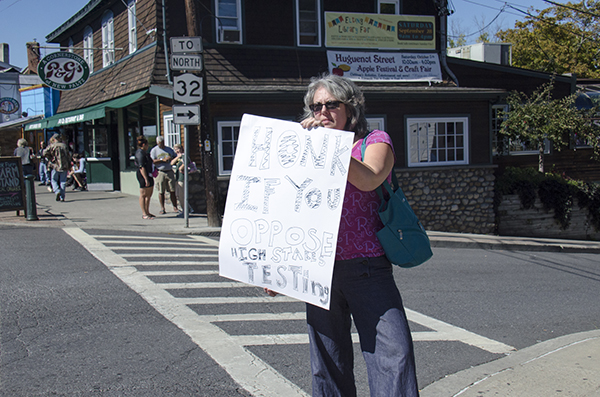

A young boy runs up and down the sidewalk in front of Elting Library on Main Street shouting, waving a hand-written sign and yelling “students are more than numbers” at passing cars. Behind him, mothers and educators stand with signs of their own, urging those driving by to “honk for better education.”
The education activist group Re-thinking Testing Mid-Hudson Region held a “Send Back The Scores” event on Saturday, Sept. 28, to raise awareness of the effects on high stakes testing on public school students. The group collected the test scores to send them to the New York State Education Department (NYSED) to show their disapproval for “invalid” testing, according to their website rethinkingtestingmidhudson.blogspot.com.
“Testing is taking over public education,” Re-thinking Testing Mid-Hudson Region member and Professor of Educational Studies Nancy Schniedewind said. “That’s not a good thing. This is hurting students, teachers, local school budgets and democratic control of public education.”
Re-thinking Testing Mid-Hudson Region member KT Tobin said she saw the future of state testing “coming down the pike” during her time on the New Paltz School Board.
“We’ve been working on creating awareness because we knew this was coming,” Tobin said. “It’s changing how we teach and how we learn. We’re teaching to the test.”
Tobin said the mandates ultimately serve to put more of a strain on the students, teachers and tax payers.
According to “Federal Mandates on Local Education: Costs and Consequences,” a discussion brief published by the Center for Research, Regional Education and Outreach (CRREO) in 2012, the “testing industry” has reaped the benefits of recent educational reforms since Race to the Top (RTTT), the “four year, $4.35 billion competitive Obama administration reform initiative” was implemented in 2012.
“There are serious challenges to this federal program’s validity, and the research upon which it is based,” the study said. “Without substantive validation, New York State and U.S. taxpayers are funding a grand and costly experiment that has the potential to take public education in the wrong direction at a time when we need to be more competitive than ever before.”
The RTTT mandates require districts to pay for curriculum redesigns, new materials and assessments to support those redesigns and the scoring systems, often privately owned, that “comply with the education law for security assurances that also require second party scoring.”
Ultimately, the costs of RTTT outweighed the federal funding received, the brief said. The aggregate costs in September 2012 came to $6,472,166, while the aggregate funding was $520,415.
“These districts had to make up a cost differential of $5,951,751 with local taxpayer dollars,” the study said.
The tests, including the New York State English Language Arts (ELA) and Math assessments are “not valid” and do little to quantify student performance, intelligence or learning, Schniedewind said.
The New York State Office of Student Assessment (OSA) said on their website that the tests “are aligned with the New York State Learning Standards and Core Curriculum, are consistent with state and federal mandates, are statistically and psychometrically sound, and yield valuable information that enables the State Education Department to hold schools accountable for the education of all students.”
According to Re-thinking Testing Mid-Hudson’s website, the validity and educational value of the tests are questionable due to oversights in its scoring and construction.
The scores are determined using top percentile scores on NAEP, SAT and PSAT exams, according to the website, using “these scores to work backwards and determine the scores a child must receive on state assessments in grades [three through eight] to eventually meet these benchmarks.”
“In other words, in order to be proficient on a NYS test, all students must achieve scores comparable to the top … students in the country,” the website said. “This is too high and sets children up for failure.”
Bianca Tanis, who attended the event with her son, said the length of these exams was too intense for many children to handle.
“All kids are different,” Tanis said. “Three hours, three days in a row — that’s a lot of time.”
Tanis said these mandatory exams, given to grade school students, are comparable to larger-scale exams adults choose to take like the medical board exams and the LSAT.
“Parents should educate themselves about the tests and scores,” Tanis said. “They need to take action.”
Re-thinking Testing founding member and former fourth grade teacher Karen Cathers taught in the New Paltz school district when fourth grade was considered the “target grade” for testing.
She said she saw the way the testing affected the kids in her classroom and the way she needed to teach. She said it was difficult to be “educationally sound” and to teach the material needed for the tests.
Cathers said the testing has more to do with “control” and “business,” than it does with education.
“It’s all corporate led. It’s about making money and control. It’s not about what’s educationally sound,” Cathers said. “However, a functional system of public education is still one thing that is absolutely necessary for democracy.”
